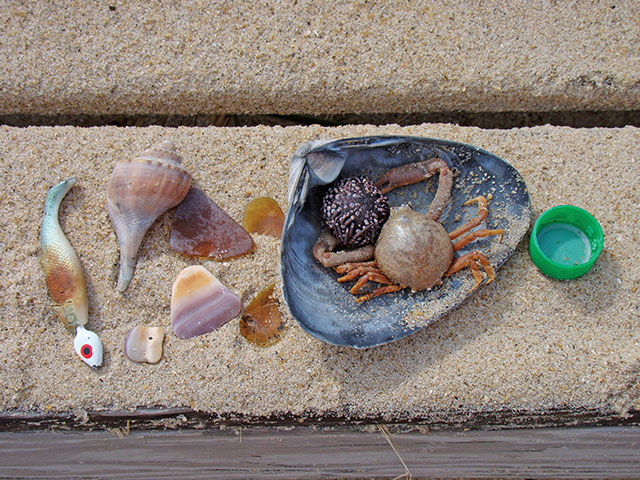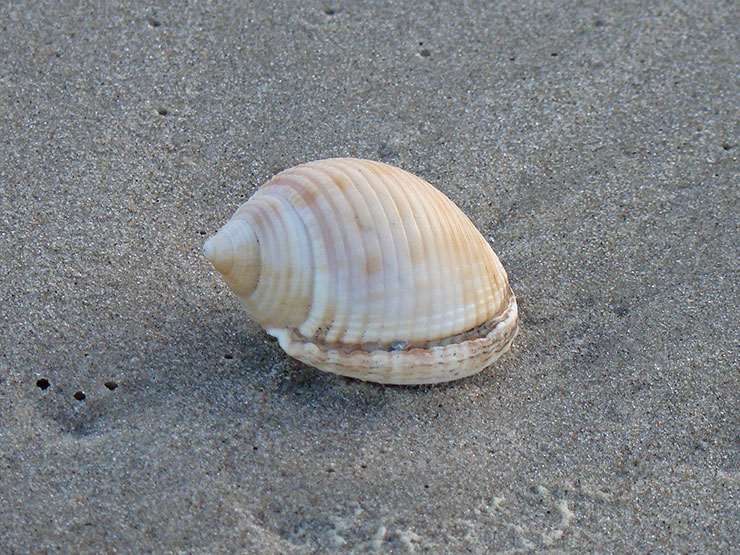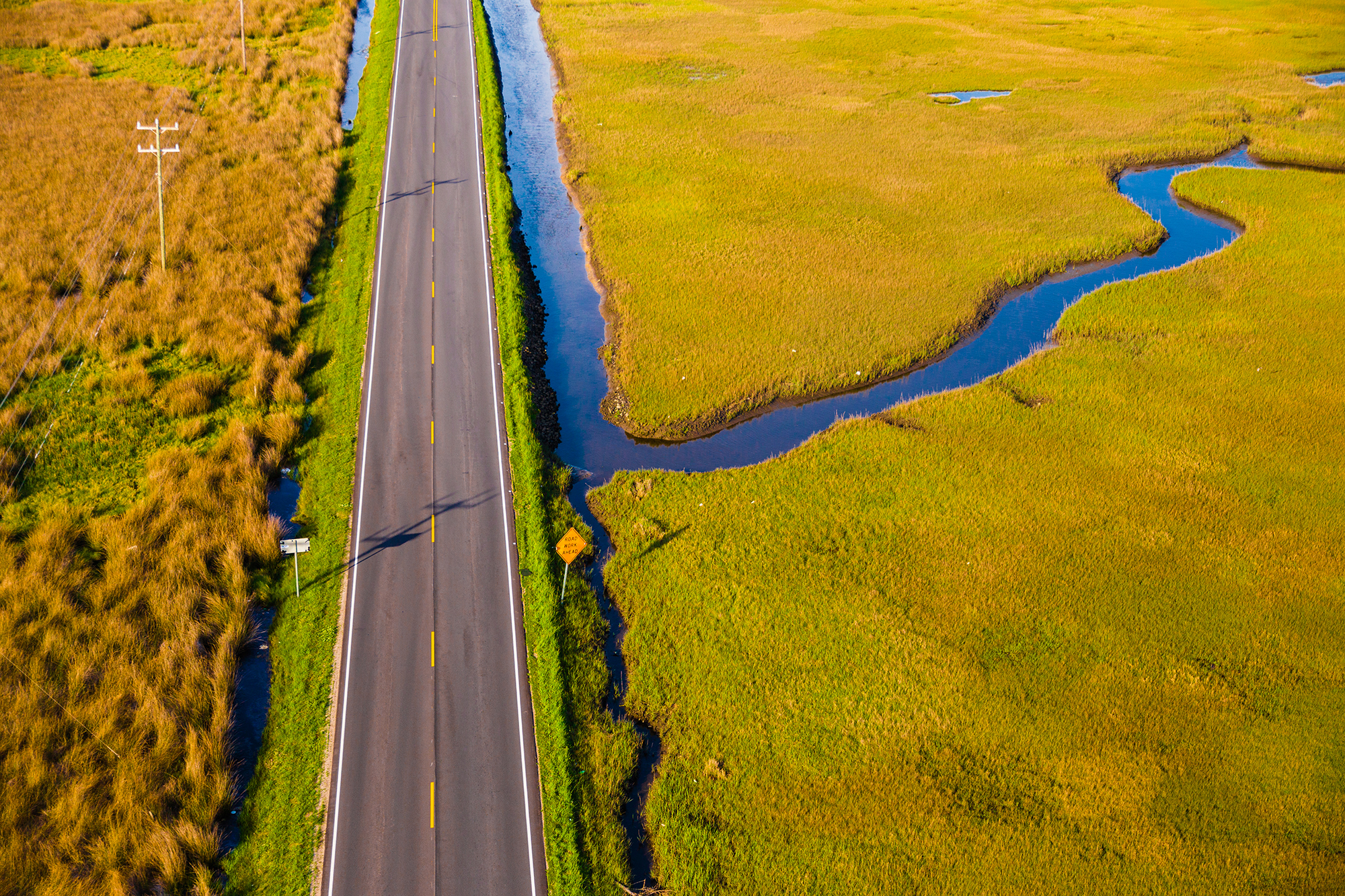Scotch Bonnet: Beachcombing Biology: The Stories Your Finds Tell

Hi, my name is Terri and I’m a beachcomber.
Yes, beachcombing can be an addiction, and I haven’t found a support group yet. But there are worse addictions, aren’t there?
Beachcombing — spending time on a beach looking for lost or discarded items, natural specimens, etc., that are useful or interesting — is a great and inexpensive way to get some exercise and meditation time, along with a dose of vitamin D. Although you can beachcomb along any shoreline, be it a pond, lake, river or bay, I’m focusing on North Carolina’s ocean shoreline.
Let’s admit it: We’re all beachcombers. Everyone looks down when they’re walking on the beach, hoping to find something curious and/or unique. We’re all waiting for the perfect shell, the prettiest piece of sea glass or the coolest beach hero.
Beach finds, both natural and man-made can arrive in several ways. Some might be left behind by humans, like plastic bags, beach toys or sunglasses. Others are transported inland by the wind, like an aerosol can from Turkey or a sea-bean. And still others are delivered from the deep by waves, such as a piece of frosted glass, an empty Scotch bonnet or a black-stained oyster shell. Whatever delivery method, these found objects intrigue and thrill us.
BEACHCOMBING GUIDELINES
Beachcombing is neither an exact science nor an activity with hard and fast rules. However, here are some things to consider when planning your next foray to the shore.
Time of year
Although the majority of people prefer to walk beaches during the warmer months, winter is a great time to search the shores. Rough waves churn up the ocean bottom and deliver shells, egg cases and more. Winter storms usually deposit more things on the sand than summer storms, and with fewer people enjoying the winter beach, there is less competition for the beachcombing booty.
Time of day

Choosing when to beachcomb is a matter of personal preference: sunrise, sunset, noon or any other time. The age-old saying “the early bird gets the worm” applies to beachcombing, especially if you’re visiting the beach during the peak summer season. Early beachcombers have first dibs on what was deposited overnight, although subsequent tides will deliver more treasures.
Searching in low light either too early in the morning or too late in the afternoon may make it more difficult to see some things. For example, it’s probably best to hunt for sea glass while the sun is higher in the sky than at dawn or dusk because the frosted surface of worn glass reflects sunlight differently than mollusk shells.
Tidal cycle
Flood tide, ebb tide or turning tide — that is the question! Most beachcombers will tell you to start searching a couple of hours before dead low tide and for 1 to 2 hours after the tide has starting rising. For more on tides, see “Rolling with the Tide” from the Summer 2012 issue of Coastwatch.
Location
This selection, again, is a personal choice. The intertidal zone, the portion of the beach that is exposed between high and low tide, is the place to find the most recent goodies delivered by the waves. But don’t discount the wrack line, an indication of a recent high tide. Seaweed and other plant material, egg cases, molts from crustaceans and additional lightweight treasures can be found along the wrack, or strand, line.
Storm winds, on top of high tides, may cause floating debris to be deposited near the dune line, so don’t skip the area adjacent to the dunes. And, if you explore a beach with no or low-profile dunes, you should look beyond those piles of sand. Who knows what you might find far away from the water.
SUGGESTED EQUIPMENT
- Wear a hat, sunglasses and sunscreen, no matter the season or the sun level.
- Dress appropriately for the weather, both existing and forecasted.
- Be careful what you pick up. It wasn’t that long ago when used syringes and other medical waste could be found on beaches.
- Don’t collect live animals. If you find a live animal washed up and drying out, please put it back in the ocean so it will live.
- Bring at least two collecting containers, such as plastic bags, buckets or mesh bags. Use one for your treasures and one for trash. Always leave the beach in better shape than when you arrived.
SPECIAL TREASURES
You might come across some of these unique finds while beachcombing.
Whelk lay their eggs in a string of capsules. This egg case is from a lightning whelk. Photo credit: Dawn and Blair Witherington.
Egg cases
Although you might uncover a variety of egg cases, they will likely be one of these three.
First are whelk egg cases. Whelks, large marine snails, lay their eggs in long strings of coin-shaped capsules. Usually laid on the bottom of the ocean or the sound, whelk egg cases can get ripped from the bottom by waves and deposited on the beach. Once the egg case has dried out, the larvae are no longer viable, and you can hear them rattle if you shake the egg case.
Break into a capsule to find 25 to 50 tiny whelk shells that will never hatch. Remember that each whelk starts out life as a small snail and gradually adds onto its shell to become an adult that can reproduce.
We have three species of whelks in North Carolina waters.
- The knobbed whelk, or Busycon carica, has large shoulder knobs around the top part of the shell. It coils to, or opens on, the right.
- The channeled whelk, or Busycotypus canaliculatus, also has its aperture, or opening, on the right. Instead of pointed fixtures around the top, this whelk has a deep channel along the spiral.
- The lightning whelk, or Busycon sinistrum, similar in looks to the knobbed whelk, has its opening on the left.
Second, you might find moon snail egg cases. To deposit their eggs on a sandy bottom, female moon snails, Neverita duplicata, also called shark eyes, create a sand collar by combining their eggs with sand and a gelatin-like substance. When left high and dry on the beach, these sand collars are so fragile that they’ll disintegrate when picked up by a beachcomber.

Finally, another common discovery is mermaid’s purses, which really are skate egg cases. Skates, with their cartilage skeletons, produce black, plastic-looking egg cases with four tendrils for oxygen exchange and to attach to submerged vegetation or structures. Each egg case contains one embryo that stays protected inside the case until the yolk is absorbed and the baby skate is ready to survive on its own. It escapes from the egg case through a slit in either end, so look for that opening on the mermaid’s purse that you find.
Although egg cases of the clearnose skate, Raja eglanteria, are the most common on North Carolina beaches, little skate, Raja erinacea, egg cases also can be found.
And if you’re wondering, you’ll never find a stingray egg case on our beaches, because stingrays have live births.
Seashells
Many mollusk shells, both whole and in pieces, can be found on North Carolina beaches. Mollusks are soft-bodied animals, most with external shells for protection. These beachcombing treasures are secreted by a part of the animal called the mantle. The mantle uses calcium carbonate extracted from the ocean water to add onto the original shell as the animal grows.
Not all mollusks have shells. Some have internal structures for support rather than external shells for protection. Sea slugs and sea hares do not have shells. Squids have an internal part called a pen, made from chitin, a polymer related to glucose. Octopuses have lost their shell altogether.
Although there are several classes of mollusks, we find the remains from mainly two groups on our beaches. Gastropods, Latin for “stomach foot,” are animals that have only one coiled shell. Whelks, moon snails, baby’s ears and Scotch bonnets are gastropods. Bivalves, or pelecypods, which is Latin for “hatchet foot,” are mollusks with two hinged shells. Think clams, oysters and scallops.
If you’re extremely lucky, or if you know where to search, you may find a Scotch bonnet, the North Carolina state seashell. The Scotch bonnet is a carnivorous gastropod that feeds on sea stars and other echinoderms. The empty shell is a beautiful beachcombing find — as long as a hermit crab hasn’t already moved in! North Carolina was the first state to designate a state seashell, and the Scotch bonnet was selected in 1965 to honor our Scottish ancestors.
Many seashells found on our beaches have secondary coloration. In other words, the shells were stained a different color after the original animal died. You may find shells that are totally, or just partially, brown. The iron in these shells has been oxidized by exposure to the atmosphere, forming the brown-colored iron oxide in the small open spaces within the shell structure.

Black shells, found mostly north of Cape Hatteras, are delivered to the beach by waves or are uncovered during barrier island movement. These shells have been buried in oxygen-poor muds on the backside of the barrier islands. Over time, the iron in the shells turns into iron sulfide, and the black shells are exposed on the beachfront as the barrier island moves landward.
This knot of discarded fishing gear has “collected” a crab, an urchin test, a sea whip and who knows what else. Photo credit: Dawn and Blair Witherington.
Sea-beans
Seeds from tropical plants that use ocean currents for dispersal are called sea-beans. Hamburger beans come from vines that grow around the Caribbean. Sea hearts are the seeds from the monkey ladder vine that grows in the Amazon River basin. These seeds are transported down rivers to the ocean where they get caught up in the circular pattern of ocean currents called the North Atlantic Gyre.
Eventually they wash up on East Coast beaches and are found by beachcombers.
Sea glass
Also called beach glass, this man-made beachcombing find is trash turned to treasure by sand, wave action and time. Sea glass can be found on most beaches, although some beaches offer more than others. You must consider the beach’s context. One near an old ferry landing, dock or trash dump might be an excellent location to find sea glass. Brown, green and white are the most common colors, but other possibilities include cobalt, teal and lavender. Finding red, yellow or orange sea glass would be like discovering the mother lode.
Beach heroes
Plastic toys left behind by children are a favorite find and are referred to as “beach heroes” by some. Army men, monkeys from “Barrel of Monkeys” and weebles, as well as cowboys and Indians are great discoveries. It’s fun to make up a story about those beach finds.
Marine debris
Floating trash that comes from ships cruising offshore can lead to fascinating questions. Finding a plastic bottle on the beach with a label written in Turkish or French is interesting. Where did it come from? How did it get to this beach? Most plastic trash on our beaches today is left behind by humans or blown onto the beaches by the winds. Before 1983 when the Marine Pollution, or MARPOL, Convention went into effect, all kinds of trash was tossed off ships, so unique items washed up on beaches everywhere.
North Carolina’s beaches are excellent places to find all kinds of treasures. Because our state includes both Virginian and Carolinian provinces — biogeographical regions north and south of Cape Hatteras, respectively — we have both northern and southern species in our waters. You can discover a variety of items here.
So, the next time you’re at the beach, get out there and beachcomb. Discover something unique, something new, something special — and share your pictures with me at terrikh@csi.northcarolina.edu.
Go to www.ncseagrant.org/s/beachcombing for a list of references.
I must go down to the seas again,
for the call of the running tide
Is a wild call and a clear call that may not be denied;
And all I ask is a windy day with the white clouds flying,
And the flung spray and the blown spume,
and the sea-gulls crying.
— Sea-Fever by John Masefield
This article was published in the Spring 2013 issue of Coastwatch.
For contact information and reprint requests, visit ncseagrant.ncsu.edu/coastwatch/contact/.
- Categories:


